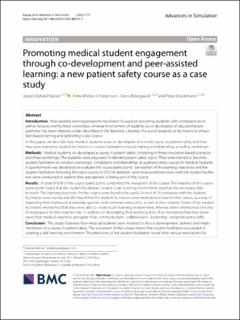| dc.contributor.author | Kayser, Jesper Dybdal | |
| dc.contributor.author | Mielke-Christensen, Anne | |
| dc.contributor.author | Østergaard, Doris | |
| dc.contributor.author | Dieckmann, Gerhard Peter | |
| dc.date.accessioned | 2023-04-03T11:40:17Z | |
| dc.date.available | 2023-04-03T11:40:17Z | |
| dc.date.created | 2023-01-20T15:03:49Z | |
| dc.date.issued | 2022 | |
| dc.identifier.citation | Kayser, J.D., Mielke-Christensen, A., Østergaard, D., & Dieckmann, P. (2022). Promoting medical student engagement through co-development and peer-assisted learning: a new patient safety course as a case study. Advances in Simulation, 7. | en_US |
| dc.identifier.issn | 2059-0628 | |
| dc.identifier.uri | https://hdl.handle.net/11250/3061803 | |
| dc.description.abstract | Introduction
Peer-assisted learning programs have been focused on providing students with competencies to deliver lectures and facilitate workshops, whereas involvement of students as co-developers of educational programmes has been relatively under-described in the literature. Likewise, the use of students as facilitators in simulation-based training and debriefing is also scarce.
In this paper, we describe how medical students were co-developers of a novel course on patient safety and how they were trained as student facilitators to conduct simulation-based training and debriefing, as well as workshops.
Methods
Medical students co-developed a course in patient safety consisting of three simulation-based scenarios and three workshops. The students were educated in relevant patient safety topics. They were trained to become student facilitators to conduct workshops, simulations and debriefings at a patient safety course for medical students. A questionnaire was developed to evaluate the course participants´ perception of the learning objectives and the student facilitators following the latest course in 2020. In addition, semi-structured interviews with the student facilitators were conducted to explore their perceptions of being part of the course.
Results
A total of 92% of the course participants completed the evaluation of the course. The majority of the course participants found that the student facilitators created a safe learning environment and had the necessary skills to teach. The learning objectives for the course were found to be useful. A total of 10 interviews with the student facilitators were conducted. We found that the student facilitators were motivated to teach in the course, as a way of improving their teamwork, leadership qualities and communication skills, as well as their resume. Some of the student facilitators mentioned that they were able to create a safe learning environment, whereas others mentioned a feeling of inadequacy for their teacher role. In addition to developing their teaching skills, they mentioned that they developed their medical expertise, alongside their communication-, collaboration-, leadership- and professional skills.
Conclusion
This study illustrates how medical students were involved in the co-development, delivery and implementation of a course in patient safety. The evaluation of the course shows that student facilitators succeeded in creating a safe learning environment. The interviews of the student facilitators reveal their various motivations for teaching, in addition to different perceptions of their experience as a student facilitator. Some expressed a positive feeling of being able to establish a safe learning environment, whilst others expressed a feeling of inadequacy when facilitating peers. In addition, the student facilitators indicated that they developed themselves both professionally and personally. | en_US |
| dc.language.iso | eng | en_US |
| dc.publisher | BMC | en_US |
| dc.rights | Navngivelse 4.0 Internasjonal | * |
| dc.rights.uri | http://creativecommons.org/licenses/by/4.0/deed.no | * |
| dc.title | Promoting medical student engagement through co-development and peer-assisted learning: a new patient safety course as a case study | en_US |
| dc.type | Peer reviewed | en_US |
| dc.type | Journal article | en_US |
| dc.description.version | publishedVersion | en_US |
| dc.rights.holder | The authors | en_US |
| dc.subject.nsi | VDP::Medisinske Fag: 700 | en_US |
| dc.source.pagenumber | 11 | en_US |
| dc.source.volume | 7 | en_US |
| dc.source.journal | Advances in Simulation | en_US |
| dc.source.issue | 17 | en_US |
| dc.identifier.doi | 10.1186/s41077-022-00212-5 | |
| dc.identifier.cristin | 2111902 | |
| cristin.ispublished | true | |
| cristin.fulltext | original | |
| cristin.qualitycode | 1 | |

